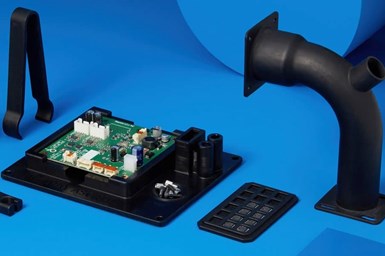Formlabs’ ESD Safe Resin Enables Manufacturers to Scale With 3D Printing
This resin is said to open up new 3D printing applications in electronics manufacturing, automotive and aerospace industries with a tough, high-quality, ESD-safe material.

Formlabs’ ESD resin enables users to 3D print custom, tough, ESD-safe parts. Photo Credit: Formlabs
Formlabs’ electrostatic discharge (ESD) resin is designed for manufacturers to reduce risk and increase yield on electronics manufacturing lines. The company says the resin is a cost-effective solution for producing static-dissipative parts designed for use on the factory floor, creating custom, tough, ESD-safe parts.
The resin was developed to hold up under rigorous manufacturing environments to create custom tools, jigs, and fixtures to protect manufacturers’ critical electronics components from static discharge. The company says the resin is well suited for tooling and fixturing for electronics manufacturing; custom trays for component handling and storage; and antistatic prototypes and end-use components.
ESD materials dissipate static electricity in order to protect components that may be sensitive to static shock, like electronics. ESD materials are not true “conductors,” but electrons are able to flow across their surfaces to dissipate static shocks if they occur.
An added benefit is that ESD materials are antistatic when grounded, meaning that small particles such as dust, powder and styrofoam won’t stick to them. In many electronics manufacturing facilities, these particles cause buildup and eventual failure for delicate electrical and mechanical systems. ESD materials for tooling and assembly procedures minimize the risk of failures both in cases of electric charge overload and static buildup. Manufacturers have traditionally relied on machined metals for these materials, but now there are solutions in 3D printing.
The company says that using ESD resin for 3D printing parts in electronics manufacturing is a less expensive and faster alternative to machining in many applications. Formlabs’ SLA printers with ESD resin now offer a solution that can be vital for specific applications and workflows across a broad range of industries.
When prototyping manufacturing parts, testing and validation require all components to function together, and electronic components need to operate smoothly. Because the toughness of ESD resin is higher than that of many other 3D printed ESD-safe materials, engineers can prototype without risk of mechanical or electrical failure, the company says.
Related Content
-
What Does Additive Manufacturing Readiness Look Like?
The promise of distributed manufacturing is alluring, but to get there AM first needs to master scale production. GKN Additive’s Michigan facility illustrates what the journey might look like.
-
ActivArmor Casts and Splints Are Shifting to Point-of-Care 3D Printing
ActivArmor offers individualized, 3D printed casts and splints for various diagnoses. The company is in the process of shifting to point-of-care printing and aims to promote positive healing outcomes and improved hygienics with customized support devices.
-
Aircraft Ducts 3D Printed in Composite Instead of Metal: The Cool Parts Show #68
Eaton’s new reinforced PEKK, tailored to aircraft applications, provides a cheaper and faster way to make ducts compared to formed aluminum.













